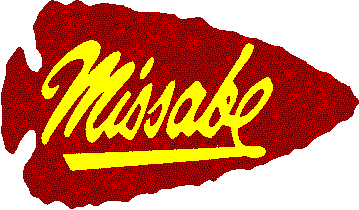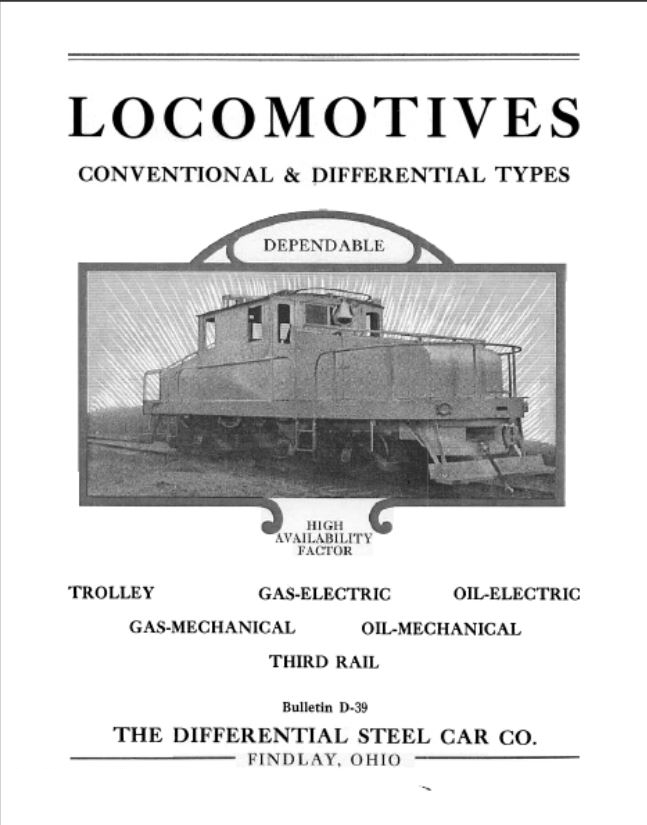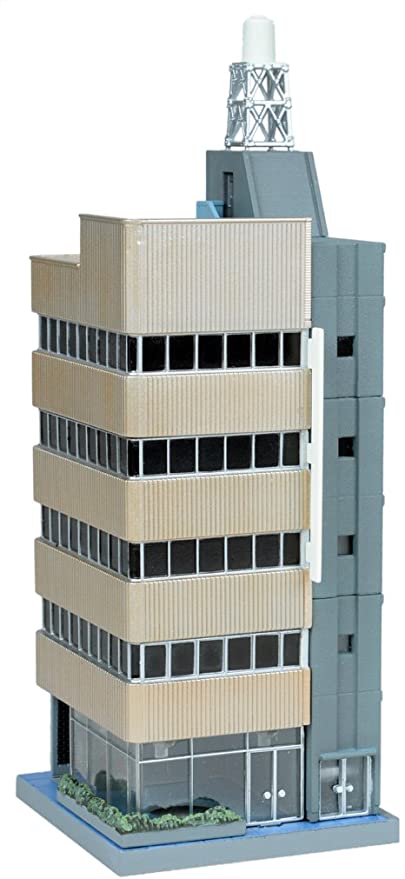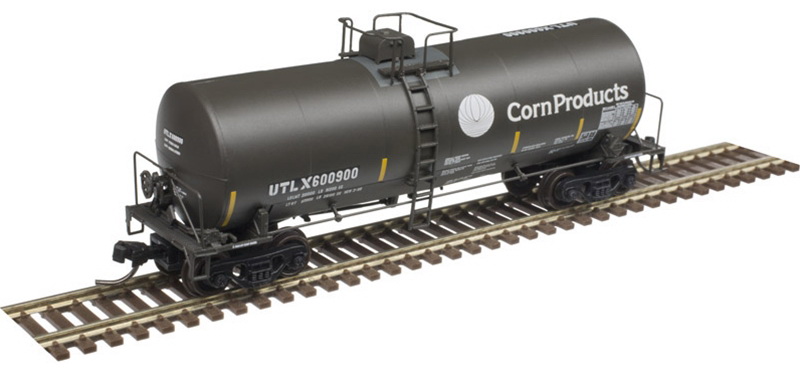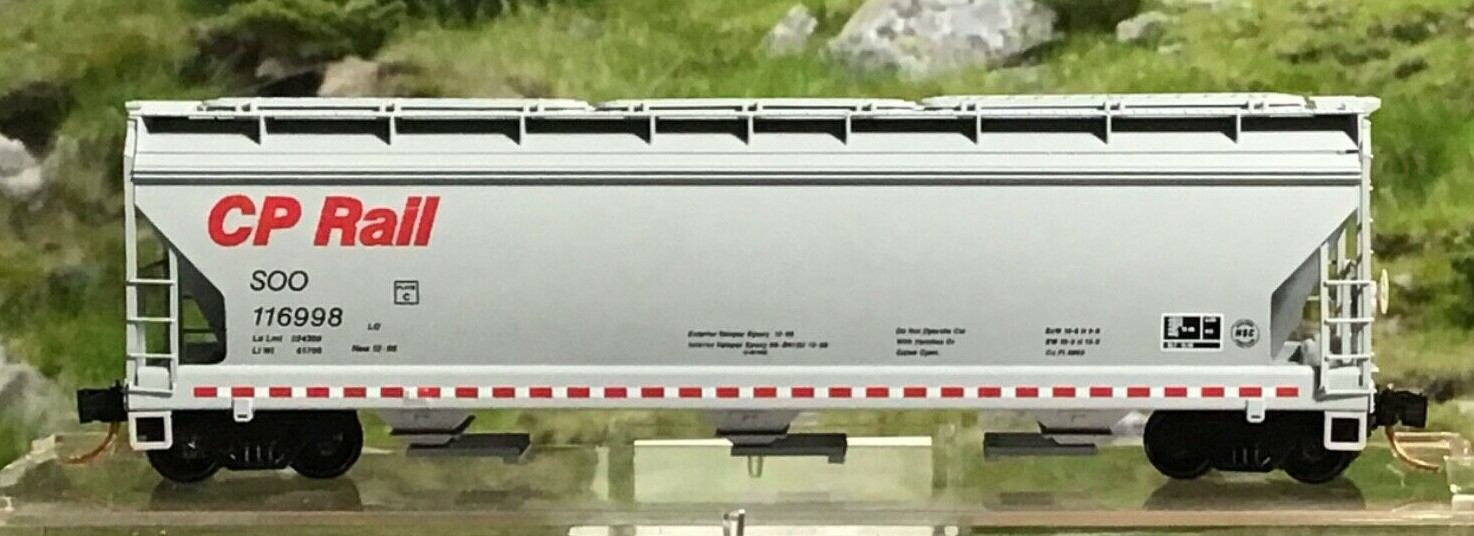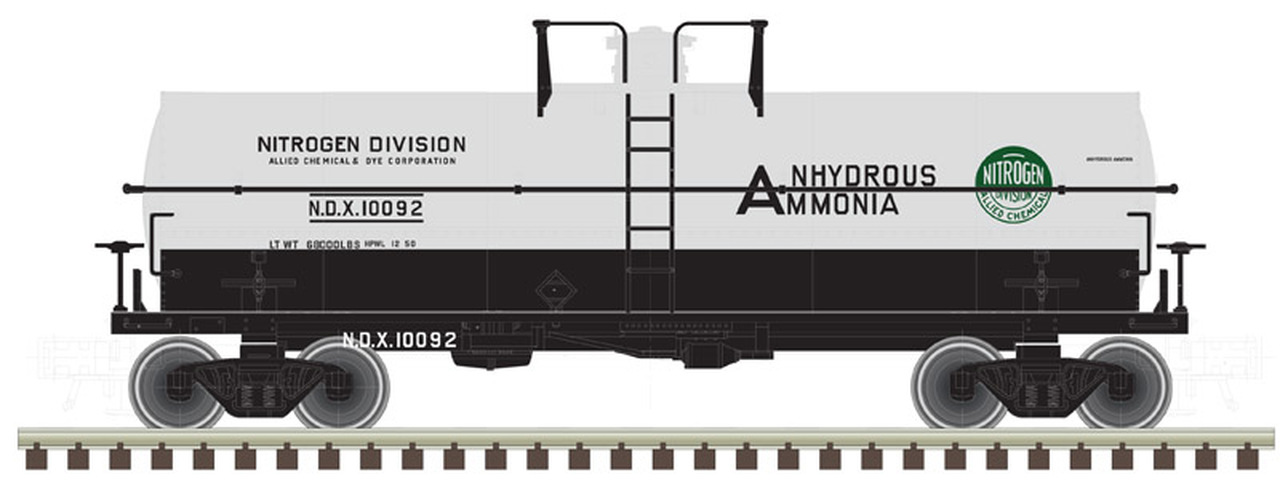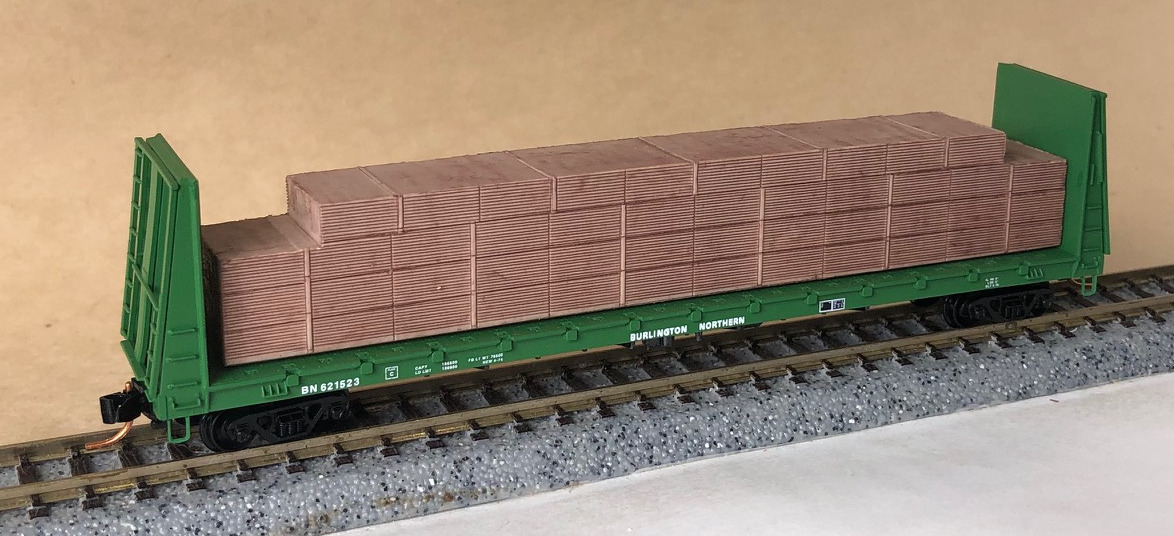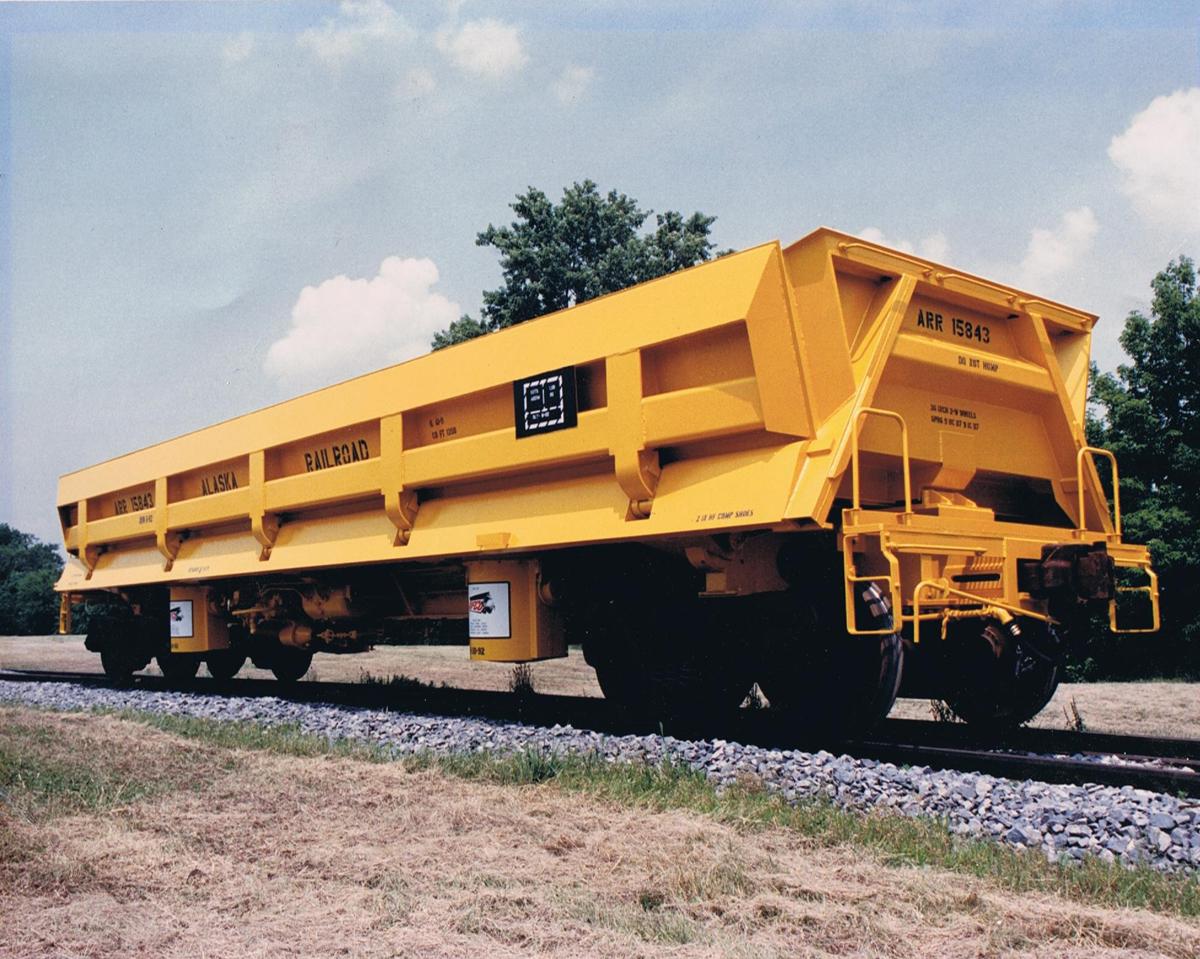Specific Item Information: Road numbers #2216, #2135, #2167
Model Information: First released in February 2007. Re-run several times.
Walthers ready-to-run N Scale Difco Dump Cars feature a detailed, injection-molded styrene body mounted on a heavy diecast metal chassis with realistic hydraulic cylinder detail for a low center of gravity and reliable tracking. Details include fine-profile end stirrups and factory-installed wire handrails. Each car comes fully assembled and features Accumate® working knuckle couplers mounted on appropriate free-rolling trucks. Cars are available individually and in limited-run three-packs for a total of four roadnumbers per roadname; an undecorated version will also be available.
Matching Rip Rap Load: Walthers 933-802
Walthers ready-to-run N Scale Difco Dump Cars feature a detailed, injection-molded styrene body mounted on a heavy diecast metal chassis with realistic hydraulic cylinder detail for a low center of gravity and reliable tracking. Details include fine-profile end stirrups and factory-installed wire handrails. Each car comes fully assembled and features Accumate® working knuckle couplers mounted on appropriate free-rolling trucks. Cars are available individually and in limited-run three-packs for a total of four roadnumbers per roadname; an undecorated version will also be available.
Matching Rip Rap Load: Walthers 933-802
Prototype History: These very distinctive cars are the railroad equivalent of a dump truck. Designed to carry up to 100 tons, they are fitted with large pneumatic cylinders and side doors, and can dump to the left or right of the tracks. While used primarily in work train service for dumping ballast, fill and rip rap, they can also be used in revenue service to carry sand, gravel, cinders, coal, limestone and other loose bulk materials used in industry.
Road Name History: The DM&IR was born in 1937 with the merger of the Duluth Missabe & Northern and the Spirit Lake Transfer Railway. The DM&N had leased the Duluth & Iron Range since 1930 and both were owned by United States Steel. The D&IR was absorbed by the DM&IR in 1938.
The DM&IR ran from the twin ports of Duluth and Superior on the Minnesota-Wisconsin border at the tip of Lake Superior, and Two Harbors, Minnesota north and northwest into the Vermilion and Missabe Ranges of northeast Minnesota. Total mileage was 357. Several of the mainlines are double track and DM&IR operated them with left-hand running. The majority of DM&IR traffic over the decades has been iron ore.
Because DM&IR has traditionally had the heaviest average trains in the nation, their steam fleet had some real monsters. 2-8-8-4 Yellowstones were the biggest. Single Yellowstones were regularly assigned to pull 18,000 ton ore trains on some of the flatter districts. Their biggest yard switchers were 0-10-0’s. DM&IR was the last of the US Steel railroads to dieselize (in 1959) so as the other roads in the US Steel family dieselized, they sent the cream of their steam fleets to the DM&IR. Mikados came from EJ&E. Bessemer & Lake Erie sent their huge Texas-type 2-10-4’s and the Union Railroad sent their 0-10-2’s. That’s not a typo, they had 0-10-2’s. They were used to replace older mallets in pusher service then ended their careers switching the ore docks.
DM&IR dieselized with SD9’s (running short hood forward), SD18’s and ultimately SD38’s. They were one of a handful of Class One railroads to get through the transition era without ever buying cab unit. The SD38 has just 2000 horsepower but has nearly the same tractive effort as an SD40 at low speeds. Many roads bought them to shove trains over the crest in hump yards, but three of the US Steel railroads used them for low speed road service. By the mid-70s, DM&IR had 98 diesels. Many years later, DM&IR was one of the roads to buy rebuilt former SP Tunnel Motors.
Raw iron ore was hauled in 70 ton 24’ long ore cars. The same cars with extension boards are used to haul Taconite. Taconite is low grade ore that is crushed to dust, then combined with bentonite clay and rolled into little balls. It’s less dense than raw ore, doesn’t require further grading, and resists freezing to the cars. This allows all-rail movement of taconite to the steel mills when the Great Lakes freeze over. In the 70s, DM&IR began draw-barring sets of 4 ore cars together which saved on brake hose failure and lowered the tare weigh
t somewhat. They referred to these sets as “mini-quads.” US Steel transferred B&LE and DM&IR to a subsidiary called Transtar. In 2001, the Transtar roads were sold to Great Lakes Transportation. In 2004, DM&IR and B&LE were sold to Canadian National.
The DM&IR ran from the twin ports of Duluth and Superior on the Minnesota-Wisconsin border at the tip of Lake Superior, and Two Harbors, Minnesota north and northwest into the Vermilion and Missabe Ranges of northeast Minnesota. Total mileage was 357. Several of the mainlines are double track and DM&IR operated them with left-hand running. The majority of DM&IR traffic over the decades has been iron ore.
Because DM&IR has traditionally had the heaviest average trains in the nation, their steam fleet had some real monsters. 2-8-8-4 Yellowstones were the biggest. Single Yellowstones were regularly assigned to pull 18,000 ton ore trains on some of the flatter districts. Their biggest yard switchers were 0-10-0’s. DM&IR was the last of the US Steel railroads to dieselize (in 1959) so as the other roads in the US Steel family dieselized, they sent the cream of their steam fleets to the DM&IR. Mikados came from EJ&E. Bessemer & Lake Erie sent their huge Texas-type 2-10-4’s and the Union Railroad sent their 0-10-2’s. That’s not a typo, they had 0-10-2’s. They were used to replace older mallets in pusher service then ended their careers switching the ore docks.
DM&IR dieselized with SD9’s (running short hood forward), SD18’s and ultimately SD38’s. They were one of a handful of Class One railroads to get through the transition era without ever buying cab unit. The SD38 has just 2000 horsepower but has nearly the same tractive effort as an SD40 at low speeds. Many roads bought them to shove trains over the crest in hump yards, but three of the US Steel railroads used them for low speed road service. By the mid-70s, DM&IR had 98 diesels. Many years later, DM&IR was one of the roads to buy rebuilt former SP Tunnel Motors.
Raw iron ore was hauled in 70 ton 24’ long ore cars. The same cars with extension boards are used to haul Taconite. Taconite is low grade ore that is crushed to dust, then combined with bentonite clay and rolled into little balls. It’s less dense than raw ore, doesn’t require further grading, and resists freezing to the cars. This allows all-rail movement of taconite to the steel mills when the Great Lakes freeze over. In the 70s, DM&IR began draw-barring sets of 4 ore cars together which saved on brake hose failure and lowered the tare weigh
t somewhat. They referred to these sets as “mini-quads.” US Steel transferred B&LE and DM&IR to a subsidiary called Transtar. In 2001, the Transtar roads were sold to Great Lakes Transportation. In 2004, DM&IR and B&LE were sold to Canadian National.
Brand/Importer Information: Wm. K. Walthers, Inc., was founded in Milwaukee in 1932 -- but really, it started years earlier, when seven-year-old Bill Walthers got his first taste of the hobby with a small, wind-up toy train for Christmas. He continued with the hobby and eventually had an attic layout comprised primarily of his own scratch-built creations. After he wrote a series of articles on building train control and signaling systems, he got so many letters from other modelers that he began manufacturing them. The first ad (in the May issue of The Model Maker) offered a 24-page, 15c catalog that listed rail, couplers, and electrical supplies. Sales were over $500.00 for the first year, and the fledgling company was off to a strong start.
Within five years, Walthers had grown so much that larger quarters were needed. Space was found on Erie Street, where everything -- from milled wood parts to metal castings to decals -- was made in-house. 1937 also saw a new line in HO Scale, featured in its own catalog. Bill brought operating layouts to the 1939 World's Fair, which gave the hobby a big boost. Soon, though, the growing possibility of war overshadowed these successes, and supplies were becoming increasingly difficult to obtain.
During the war, model manufacturers were ordered to stop production in order to conserve critical metal supplies. Walthers produced what it could from nonessential materials. A series of ads in 1943 saw Bill literally scraping the bottom of a barrel! The postwar boom meant rapid growth for the hobby; however, small homes and new families left no room for O scale layouts, and many modelers moved to HO Scale.
The next twenty years brought great change. In 1958, Bill retired and his son Bruce took over. Just as full-size railroads were being hard-hit by new technology, so too were model railroads. Leisure time was spent in front of the TV set, not the train set. In 1960, Walthers became a full-line distributor of other manufacturers' products while continuing expansion of the Walthers lines. By the start of the 1970's, business was booming again, and Bruce's son Phil joined the company.
Expansion and diversification continue under Phil's tenure. The establishment of the Walthers Importing Division added several international lines. The manufacturing plant was modernized. Code 83 track was introduced in 1985, giving layouts more realistic proportions. In 1990, the Cornerstone Series buildings were unveiled. Combining a freight car with a related industry, the Cornerstone Series makes it possible for modelers to duplicate authentic operations, enhancing layout realism. The Train Line Deluxe Sets and locomotives debuted in 1994. These sets feature the detailing of serious models and an affordable price -- allowing newcomers to get started, and then build-on to their first set, rather than replacing it.
In 2005, Walthers purchased Life-Like from Lifoam Industries. With this purchase Walthers acquired the Proto Lines that have become the backbone of their locomotive and rolling stock segments.
Today, Walthers continues to expand, improve and develop a wide range of products. Their latest selection can be found throughout Walthers.com and their printed catalogs, along with items from over 300 other manufacturers.
In December 2017, Lowell Smith announced the ‘purchase of tooling’ of the Walthers line of N Scale passenger cars (sleeper, coach and baggage cars), and in June 2018, Atlas announced that it will purchase all N scale locomotive and rolling stock tooling owned by Walthers, including the Walthers N tooling as well as former Life-Like tooling. This divestment puts an end to Walthers involvement as a manufacturer of N scale rolling-stock, though it will continue its range of N scale structures.
Within five years, Walthers had grown so much that larger quarters were needed. Space was found on Erie Street, where everything -- from milled wood parts to metal castings to decals -- was made in-house. 1937 also saw a new line in HO Scale, featured in its own catalog. Bill brought operating layouts to the 1939 World's Fair, which gave the hobby a big boost. Soon, though, the growing possibility of war overshadowed these successes, and supplies were becoming increasingly difficult to obtain.
During the war, model manufacturers were ordered to stop production in order to conserve critical metal supplies. Walthers produced what it could from nonessential materials. A series of ads in 1943 saw Bill literally scraping the bottom of a barrel! The postwar boom meant rapid growth for the hobby; however, small homes and new families left no room for O scale layouts, and many modelers moved to HO Scale.
The next twenty years brought great change. In 1958, Bill retired and his son Bruce took over. Just as full-size railroads were being hard-hit by new technology, so too were model railroads. Leisure time was spent in front of the TV set, not the train set. In 1960, Walthers became a full-line distributor of other manufacturers' products while continuing expansion of the Walthers lines. By the start of the 1970's, business was booming again, and Bruce's son Phil joined the company.
Expansion and diversification continue under Phil's tenure. The establishment of the Walthers Importing Division added several international lines. The manufacturing plant was modernized. Code 83 track was introduced in 1985, giving layouts more realistic proportions. In 1990, the Cornerstone Series buildings were unveiled. Combining a freight car with a related industry, the Cornerstone Series makes it possible for modelers to duplicate authentic operations, enhancing layout realism. The Train Line Deluxe Sets and locomotives debuted in 1994. These sets feature the detailing of serious models and an affordable price -- allowing newcomers to get started, and then build-on to their first set, rather than replacing it.
In 2005, Walthers purchased Life-Like from Lifoam Industries. With this purchase Walthers acquired the Proto Lines that have become the backbone of their locomotive and rolling stock segments.
Today, Walthers continues to expand, improve and develop a wide range of products. Their latest selection can be found throughout Walthers.com and their printed catalogs, along with items from over 300 other manufacturers.
In December 2017, Lowell Smith announced the ‘purchase of tooling’ of the Walthers line of N Scale passenger cars (sleeper, coach and baggage cars), and in June 2018, Atlas announced that it will purchase all N scale locomotive and rolling stock tooling owned by Walthers, including the Walthers N tooling as well as former Life-Like tooling. This divestment puts an end to Walthers involvement as a manufacturer of N scale rolling-stock, though it will continue its range of N scale structures.
Item created by: Alain LM on 2019-07-20 03:31:09. Last edited by CNW400 on 2020-06-04 12:34:36
If you see errors or missing data in this entry, please feel free to log in and edit it. Anyone with a Gmail account can log in instantly.
If you see errors or missing data in this entry, please feel free to log in and edit it. Anyone with a Gmail account can log in instantly.




